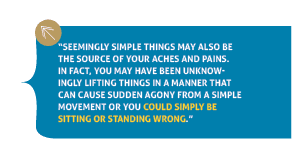Experts estimate that nearly 80% of people will experience a back problem at some time during their lives. If you’re one of the many who suffer from lower back pain, you know that it can feel like a never-ending curse that makes daily life more difficult. Read on to discover what might be causing your back pain, what risk factors may make you more prone to aches and pains, and what you can do to end your back pain issues for good.
By Alexabdra Hruz
Full PDF here.
The pain is familiar to many. Discomfort can range from aching muscles or numbness to sharp, shooting pain which radiates from the lower back through the back part of the leg, limiting movement and making ordinary tasks difficult or 


What’s Causing Your Back Pain?
So what’s the culprit behind your lower back issues? Sometimes, it’s related to getting older. Dr. Hodges says disc degeneration past age 55 is a major cause of lower back pain. Disc degeneration can be due to aging or degenerative conditions like arthritis or osteoporosis. If discs continue to degenerate and weaken, it can lead to a ruptured disc and even more pain.
In other cases, poor physical fitness and/or being overweight can contribute to back pain. If there is too much weight put on the back, it can lead to damage and pain. Weight gain is one reason why pregnant women often have back pain.
Sometimes, chronic back pain is due to heavy use-related injuries, like a strained muscle or torn ligament. A variety of things can lead to these kinds of injuries – from participation in sports to jobs requiring lifting, pulling, and pushing while twisting the spine. In some cases, you may have been unknowingly lifting things in a manner that can cause sudden agony from a simple movement.
Other seemingly simple things can be the source of aches and pains. Two common risk factors for back pain include poor posture while seated and incorrect standing position. Your pain could simply be a matter of sitting, standing, or sleeping in the wrong position. Other risk factors for back pain include (but are not limited to):
- smoking – this can cause the spinal discs to degenerate
- psychological stress and depression
- hereditary conditions and/or skeletal irregularities
- Sometimes, past health problems can provide insight into the future. If you’ve had surgery or previous health conditions, back pain may result. Knowing what risk factors in your life may lead to back pain is key to alleviating problems or preventing them altogether.



Center for Spine and Pain Medicine, P.C. – Ambulatory Surgery Center
Preventing Back Pain
Back pain is preventable – the key is to be proactive. According to Dr. Sadiq Sohani, an anesthesiologist and pain medicine specialist at Center for Spine and Pain Medicine P.C. – Ambulatory Surgery Center, staying healthy is one of the best preventative steps. “You need to have a healthy lifestyle, which includes seven to eight hours of sleep per night. This keeps muscles relaxed and keeps you fresh and energetic,” Dr. Sohani says.
It’s always best to consult a doctor before engaging in any treatment, but following these additional tips may be helpful in easing current back pain and avoiding issues in the future.
Exercise smart. Low-impact workouts, including swimming and walking, can build strength without harmful jolting. Exercises that strengthen the core and back may also prevent potential back aches. Make sure you’re stretching thoroughly before doing any activity to prevent back issues.
Keep a healthy weight. Being overweight is a risk factor for lower back pain, and extra pounds can make a small back problem turn into a much bigger deal. A healthy diet that keeps you trim and



Chattanooga Neurosurgery and Spine
takes pressure off your frame might also help with health
issues in the long run. “Keep your nutrition balanced and adequate. Eat protein and minimize carbohydrates such as sweets and bread which can lead to weight gain and weakness of muscles,” says Dr. Sohani.
Lift with your legs. You’ve probably heard this advice before: lift with your legs, not with your back. If lifting can’t be avoided, make sure you’re using the proper technique.



Canter for Sports Medicine and Orthopedics
Improve your workstation. “Many patients are sitting in a chair with inappropriate posture, which means the back and abdomen muscles are not supporting the back well,” Dr. Sohani says. To remedy this, Dr. Boehm recommends using an ergonomic, back friendly chair which will provide good lumbar support if you sit most of the day.
If you’ve followed these tips and still have back pain, don’t get too worked up. According to Dr. Hodges, back pain sometimes just comes with age. “By and large back pain is rather benign. By that I mean back pain can hurt but in many cases it is not dangerous,” he says.
Treating Your Chronic Back Pain
Most back pain will clear up on its own after a few weeks. “The most common quoted number would be 90% of acute back pain resolves in three to four weeks with simple anti-inflammatories and a maximum of one to two days of bed rest, even for severe cases,” says Dr. Jay Jolley, a spine specialist at Southeastern Spine. Light activity is recommended during recovery, and over-the-counter pain medications may be all that is needed to improve your condition. But if the pain persists, you may need to seek additional care. “See a doctor if the pain is associated with trauma, such as a fall, or if it’s associated with pain shooting down the leg,” says Dr. Jolley. “If the pain is not allowing you to participate or enjoy life as much is you’d like to or if it is interfering with sleep or work for more than a few weeks, get evaluated.”
When diagnosing your back pain, a doctor will take your medical history and do a physical exam. They may also use several tests to determine the extent of your back pain issues.
Physical therapy. “Physical therapy does two things,” says Dr. Boehm. “It strengthens the core and stretches muscles to try to manage discomfort until pain goes away.” A physical therapist has a wide variety of treatments at his or her



Spine Specialist and Surgeon, Southeastern Spine
disposal to help treat back pain, including heat, ultrasound, electrical stimulation, and muscle-release techniques. A PT can also teach you exercises that reduce pain and increase your flexibility, which can alleviate discomfort and make your muscles stronger to prevent pain from returning.
Chiropractic work. The American Chiropractic Association reports that chiropractic spinal manipulation can be a highly effective treatment for lower back pain. One study even suggests that chiropractic patients felt that their lower back pain was much improved after treatment.
Cold/heat therapy. Alternating cold packs with heat therapy is a do-it-yourself treatment that can often clear up back discomfort with minimal effort.
Medication. Before seeing a doctor, drugs like aspirin, naproxen sodium, and ibuprofen can help ease your aches. If your pain is severe enough, your doctor may prescribe you with other medication, but be sure to explore all your options before resorting to prescription pills. “You don’t want long-term use of narcotics, because you can become dependent on medication,” says Dr. Sohani. “We try to take preventative and nonsurgical measures by performing X-ray guided spinal injections to accurately diagnose and treat the pain. This allows for long-term pain relief and helps to avoid prolonged use of medications. Over 70% of patients get better this way and go on with their normal lifestyles.”
Injections. Sometimes after a prolonged period of consistent back pain, doctors may decide that an injection of the anti-inflammatory medication, cortisone, may be necessary to bring relief.
Surgery. Experts say that spinal surgery is a last-resort option, only to be considered if there is nerve damage or if the pain does not resolve over a long period of time. “As a last resort, surgery may be of benefit to a certain number of patients,” says Dr. Jolley. “Nowadays minimally invasive techniques are prevalent, and they typically allow a quicker return to work and play compared to past techniques.”

